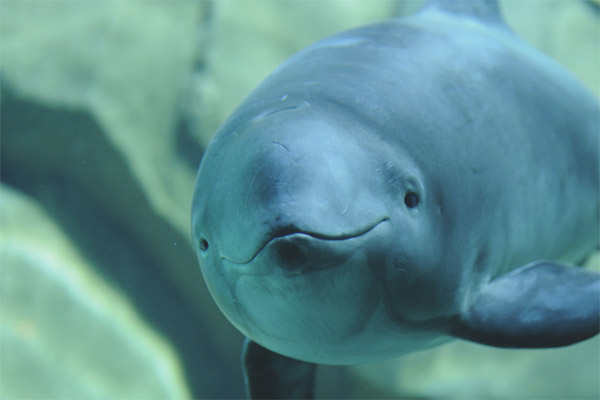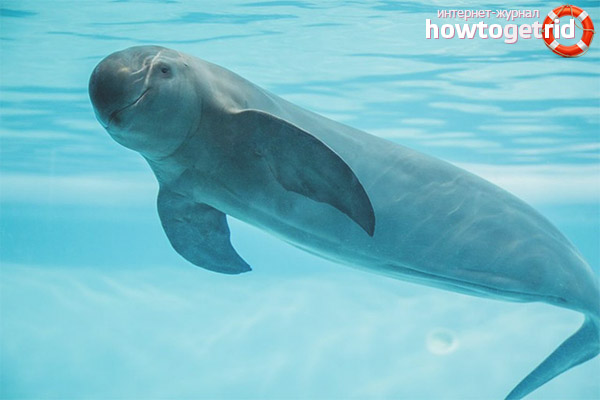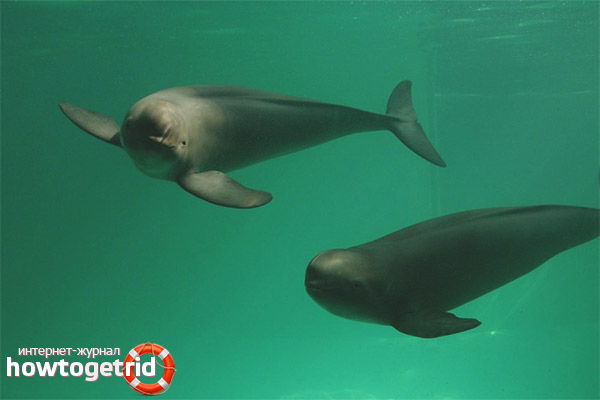The content of the article
Under porpoises are not meant at all fluffy pets that are kept at home. These animals resemble dolphins in their appearance. And they got the name because they are a bit similar to the pig.
Description
- It has already been mentioned above that, in terms of their external characteristics, the individuals under discussion resemble well-known dolphins. The head is distinguished by small overall data; the nose is separated from the frontal part and stands out against the general background. The dentition concentrates about 50 teeth, which differ in small size.
- Along the length of the body, animals are drawn up to 2 m. The body in the upper part is pigmented with dark gray, almost black. In the side sections and the abdominal cavity, the color is lighter. Also on the body of some animals there are spots of light tone.
- The stomach can be completely white.It contains strips of gray pigment. The back has a fin not too large format. The tail fin has a horizontal landing.
- Regarding gender differences, females weigh more than males. They grow to 80 kg., While male pigs by weight are about 60 kg.
Special features
- Understood with overall characteristics and pigmentation, now we will consider other aspects. Individuals of both sexes live about 12 years. They reach maturity at 4 years, so they can multiply. Pigs are fertile. The female bears offspring for about a year, but not less than 9 months, it all depends on the individual characteristics.
- The food mainly includes small fish, including bull, hamsa, atherina, etc. In order to feed themselves, it is necessary to consume at least 5 kg of female gender per day. fish. Often, poachers or fishermen put nets into which pregnant females fall. At this time they are very active, so they easily fall into the trap. The female dies, and the cubs die.
Threat of sight
- Since the distant 1960s, these animals were threatened, they were on the verge of extinction. But there was a ban on fishing, respectively, the threat was partially over.However, there remain some aspects that pose a certain danger to the pigs.
- These include bottom grids, which are aimed at catching flounder, sturgeon, catrans, etc. These animals do not specifically fall into the trap, but cannot escape from it. In the Black Sea about 1.5 thousand individuals die annually in this way.
- Also to the danger include shipping production. Due to the fact that the dolphins are naive, they swim up too close, getting fatal injuries. Because of this, reproduction ceases, some adult pigs die.
- Feature of the skin is considered the ability to accumulate toxic substances. When environmental pollution dolphins are poisoned. Their body absorbs poisons, which means that painful and slow death occurs.
- Some members of the species die simply because of a lack of food. As you already understood, individuals consume mostly small fish. Fishermen catch it massively, not leaving a lot of food for the dolphins to survive.
- It is impossible to exclude from the potential threats of viral infections, which often suffer from such representatives of the water space. They are sick and because of parasites.Also on the number of individuals affects a sharp change of weather, frost or excessive heat.
Living in captivity
- These individuals are very poorly adapted to the environment that can provide content in captivity. Under such conditions, breeding pigs can be forgotten, they simply can not do it.
- If representatives of the species are kept in special places, their life span is reduced from 12 years to a couple of months. That is, the animal does not even have time to reach puberty. Only a few live to 1.5 years.
Behavior
- The characteristics of this type include the reluctance to live in large families. They can stray into groups of 5 individuals, but often swim in pairs. Some even feel good alone. There is a possibility that the pigs will gather a large number, but this will happen only during the period of the jamb.
- These individuals do not have a nomadic way of existence. They are constantly in their chosen habitat, they feed here, and breed here.
- These animals are good swimmers.They move closer to the upper layer of water, jumping and rolling over. The peculiarity is that individuals do not cause the movement of water, so their movements are barely perceptible.
- Pigs try to stay away from crowds and those who prefer to swim with scuba diving. Some individuals in a comic form emerge and swim with the help of the caudal fin practically in an upright position.
Breeding
- The mating period for the considered individuals mainly begins from the end of spring and lasts until the end of summer. It is noteworthy that during all this time, females mate with several males. After the breeding period ends, the pregnancy lasts about 10 months.
- Often 1 baby is born. Only in rare cases, there are 2 babies. An interesting fact is that newborns can weigh up to 10 kg. The length of their body reaches about 75 cm.
- Do not forget that the animals represented are mammals. Therefore, babies feed on breast milk up to 1 year. Such individuals reach sexual maturity at about 4 years.
- The female porpoise may well produce offspring every year.Sometimes these individuals take a break of several years. In the wild, animals represented live no more than 20 years. Most often, this figure does not exceed 17 years.
Nutrition
- Most often, the individuals in question try to stick to the coastal area. They do not seek to swim away into deep waters. In the daily diet mainly includes small fish of various species.
- Often, such animals prefer salak, capelin and herring. As an exception, when there is not enough food, porpoises can eat crustaceans, squid and algae. On the day of such animals require about 10 kg. products.
Status
- It may be regrettable, but such wonderful animals are on the verge of extinction. Often the causes of this are global warming, colossal fishing, poaching, military exercises and general water pollution.
- In addition to the above problems, porpoises often suffer from natural threats. Often, considered individuals die in large numbers due to parasites and various diseases.Numerous studies have confirmed that most of the animals discussed are stranurus (roundworm).
- Such parasites completely damage the ears of individuals. In addition, porpoises are massively killed due to harsh climatic conditions. Because of such a sad situation, animals are listed in the Red Book of many countries. The law prohibits to catch the considered individuals. Otherwise threatens a large fine.
- For the rest, in any specialized purposes, these animals are not caught. The problem lies elsewhere. When a large number of fish is caught, small porpoises fall into the net. Because of this, they die in large numbers. Whenever possible, fishermen unravel nets and release porpoises.
The enemies
- Natural and the most dangerous enemies in the aquatic environment for porpoises are white sharks and killer whales. In addition, the bottlenose dolphins are no less dangerous for the represented individuals.
- Such animals kill porpoises not for food, but to reduce competition for fish. The problem is that bottlenose dolphins and porpoises eat the same fish. As a result, the first eliminate competitors.
- Porpoises are often attacked by lamprey. Most often, such pests leave behind open wounds and spots on the body of the treated individuals.
Some believe that it is because of the voracity of this lover of the aquatic environment so called. People refer to members of the family as murators, stupid dolphins and flanks. But let's not get ahead of ourselves, we will study the most important features in turn, so that you can make your own opinion.
Video: porpoise (Phocoenidae)














To send